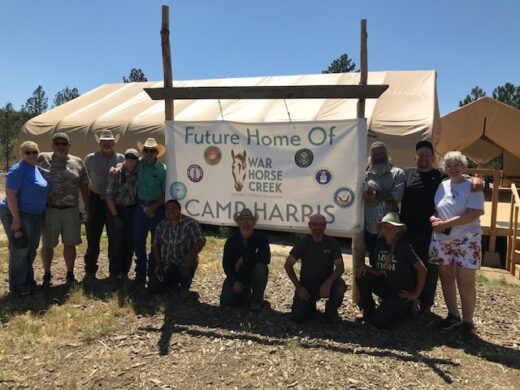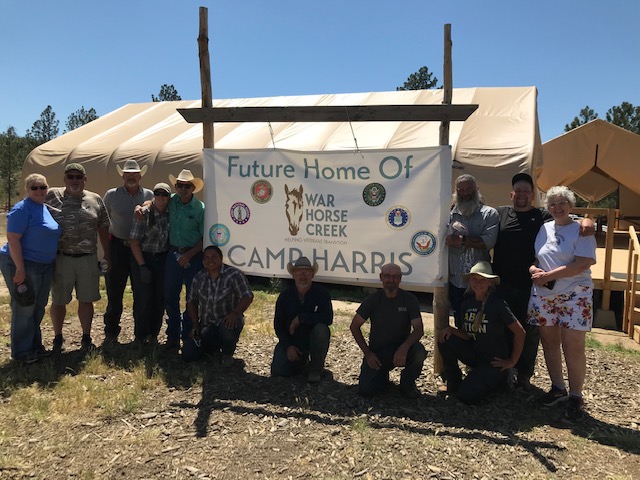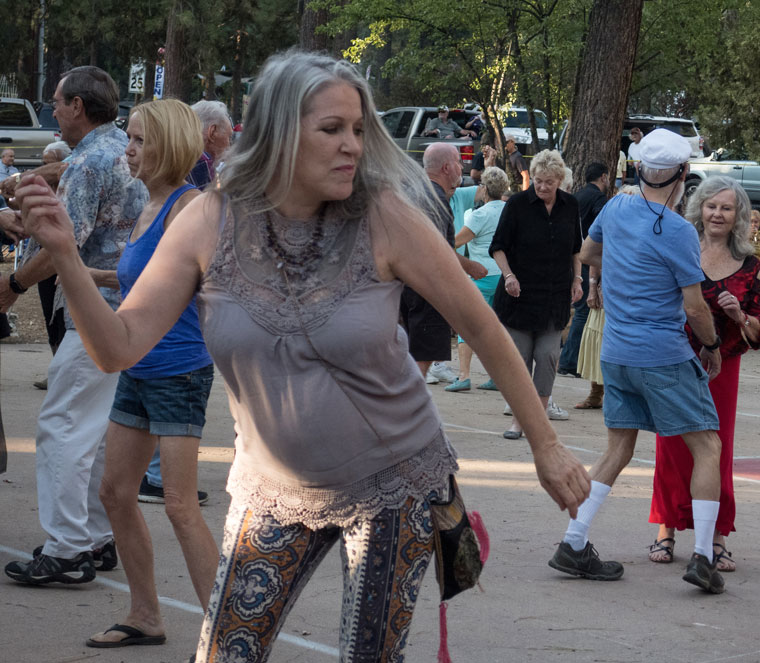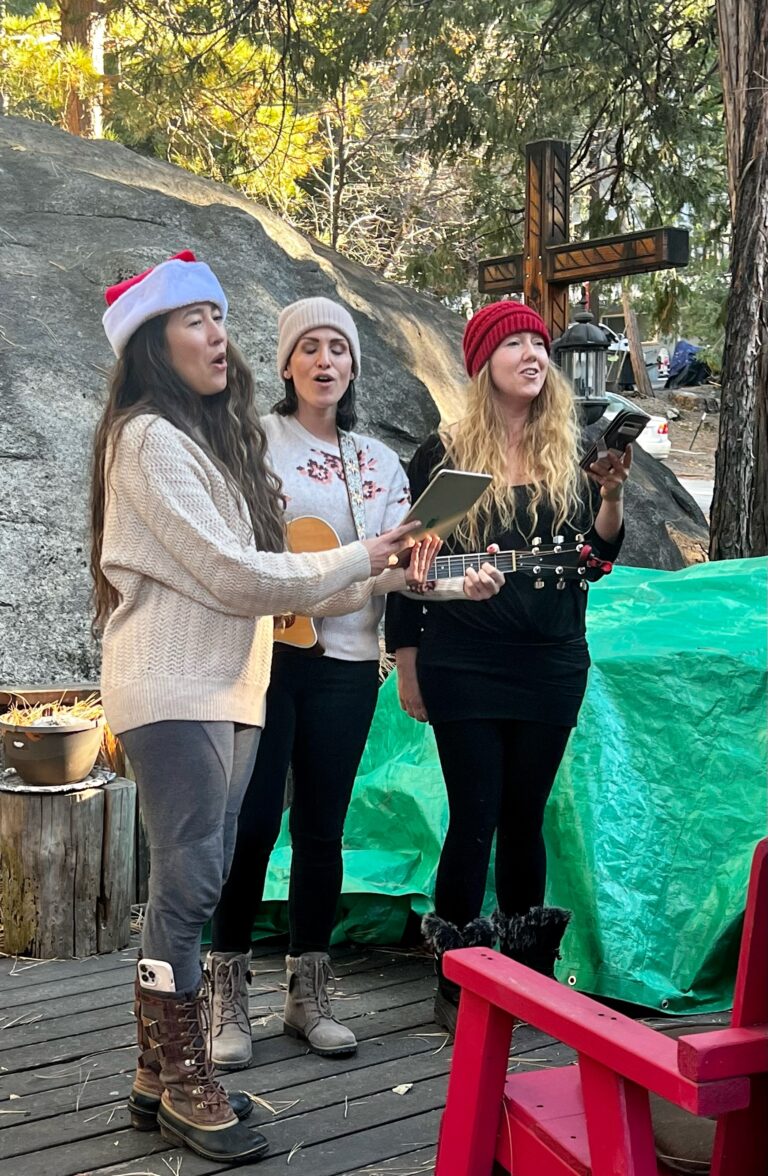A group of veterans on the last leg of a cross-continent ride in a covered wagon spent this last weekend at Living Free’s War Horse Creek camp. The vets are drawing attention to a number of causes that help veterans deal with Post Traumatic Stress Disorder (PTSD) and successfully reenter civilian life. Their mission dovetails with that of War Horse Creek, where veterans meet and work with rescued wild mustangs, learning about the horses and themselves.

PHOTO BY DAVID JEROME
Luke Reinhold of Troy, Illinois, explained the Veterans Promise Kept PTSD ride.
LR: “In 1967, Jessie Morton and Ray Cropper left a Pennsylvania horse farm and went to Vietnam. During the Tet Offensive in 1968, they promised each other that if they made it home they would drive a covered wagon across the U.S., coast to coast.
“Ray didn’t come home. Thirty-one years ago, Jessie built a wagon, found a team of Belgian draft horses and headed east from St Louis, Missouri. A hundred days later he ended up at the wall in D.C. where he paid his respects to Ray. He left there and finished his journey east at Ray’s graveside in Beverly National Cemetery in New Jersey. He made the East Coast. We’re helping him make the West Coast.
“We left St. Louis heading west four years ago. We travel four weeks a year; first year we made 413 miles to Bellville, Kansas. Since then, Jessie has complications from Agent Orange [exposure] and can’t travel. All these men and my wife and Patty Rudolph are helping fulfill the promise.
“One year we did 433 miles to Colorado Springs. Two years ago, with COVID, we could not travel. Last year we drew a line straight down from Colorado Springs, Cimarron, New Mexico to Flagstaff, Arizona, 615 miles. This year we left Flagstaff April 21, and will hit the ocean and fulfill [Jessie’s] foxhole promise on Monday the 16th in Oceanside.”
The group uses scouting cars to find safe routes for the wagon. Readers imagining getting stuck behind a covered wagon on highways 74 or 243 can rest assured that the side trip from Palm Springs to Mountain Center was done by truck.
LR: “Along the way we are raising awareness for PTSD and disabled vets. Rusty Fritts, founder of 2 Love Equine Assistance, provides horse therapy for disabled vets and troubled children in Lathrop, Missouri, for free. Also, for Dogs That Help [a nonprofit in High Ridge, Missouri providing free dogs for disabled vets and first responders.] All-volunteer, not a penny to humans.”
TC: “What do you want to tell readers about PTSD?”
LR: “For the young veterans, it’s not weakness to ask for help, it’s strength. I was one of the young vets coming home. My first wife made me go to get help; that’s where I met Jessie, that’s where I got the help I needed. I wouldn’t be here without them. “
Luke has health issues, uses a walker; “they keep trying to figure out what’s wrong,” suffers from seizures and has bad knees from a fall overseas. These challenges may slow him down a bit but have not prevented him from helping others.
TC: “How many of you are traveling in that wagon?”
LR: “Nine of us in the wagon. I can’t drive and deal with the horses, I do logistics, coordinate. Everyone is trained to drive the wagon. Patty Rudolph is a retired RN. McDaniels takes care of all the dogs. There are four, my service dog, [another dog] in training, two stock dogs. Nine people, four horses, four dogs. Like being in a unit again. Everyone has their own job and watches out for each other.”
TC: “How did you end up here?”
LR: “We showed up on their doorstep last week, we needed a place to stay. A bunch of us are doing construction here. Ray’s War Horse Creek, helping veterans transition into civilian life by working with mustangs, wild horses. Anybody wants to donate can find us on Facebook or follow us at veteranspromisekept/ptsdride. If they want to donate, do it to War Horse Creek.”
Ray Barmore is Living Free’s executive director, and the creative force behind War Horse Creek. He described the program and its value for veterans.
RB: “The thing about mustangs is they are hyper vigilant. They have to be to survive. You have a hyper vigilant prey animal. And the veteran is a hyper vigilant predator. Apex predator and apex prey, and they have got to get along. The way it works is the prey animal is not going to change. It will continue to be a mustang. For there to be communication the veteran has to change. That change of slowing down, thinking before reacting, developing a compassionate feeling for the horse, that is the whole purpose of this program.”
Ray outlined one difference between horse and human brains, the lack of a developed frontal lobe, the part of our brains responsible for planning and making generalizations.
RB: “The military trains for instant reaction. Horses don’t have a frontal lobe, they go from amygdala [the threat-assessing part of the brain] to instant reaction. What we want to do is get people to stop, slow things down. The key to horses is your ‘ask’ has to be as quiet and polite as you can make it, and if you don’t get it you need to quiet your response and think about what you have to do to get the reaction you want out of the horse. In the military, it’s the antithesis: you have a trained reaction, you escalate to get your desired outcome. They have to do that to survive in the military, but you can’t do that in civilian life.
“Rationally enough, when people get around a horse they treat it like a big dog, and you don’t. Dogs are predators — you reward them with food, with treats. With a horse, being a prey animal, their reward comes with the release of pressure. When the predator stops chasing them.”
TC: “Can you describe that?”
RB: “You ‘ask’ as quietly as you can. As soon as the horse even thinks about doing what you ask, you stop asking, you let them move in that direction. They move into the release. If you pull hard the horse is going to pull back and brace against you. If you ‘ask’ with the least amount of pressure, and as soon as they start to lean in and move their nose forward, you let go of the pressure, you release. We get to the point where you pick up the rope and indicate that you want the horse to come to you and the horse responds, the horse becomes very ‘light and soft.’”
TC: “You can’t out muscle them, can you?”
RB: “No, you’re not going to muscle around a 1,000-pound horse.”
Ray is not a vet, just a “broken down old horse-shoer.” But as a young man during the Vietnam era, he noted the change in friends who served.
RB: “A lot of friends came back from combat. They were different, We didn’t know what PTSD was, but we weren’t going to abandon them. We sat up late nights doing a lot of drinking, a lot of talking. That’s all we knew how to do.”
TC: “How did War Horse Creek start?”
RB: “That’s an interesting story. I started working at Living free in 2013. Randall Harris, then-executive director of Living Free, came into my office to ask if we could rescue mustangs. I said, ‘Yes we can.’ The first mustangs arrived in 2016. We spent a year figuring out what we could do with the mustangs once we had them here. As we were thinking about that we got a phone call from Pasadena City College, a program called Boots to Books for veterans. They were coming up for the weekend, 25 vets, and wanted to know, was there any work around the place they could help with? They came up on a Saturday and started doing volunteer work for us.
“They got all their work done in the morning, and we sat down to lunch. What to do now? Randall got the idea, ‘Let’s go play with the horses.’ Some of [the vets] were grooming them, some working in the round pen. There were some breakthroughs … You could see things happening inside them, and expressing themselves externally; there were changes. As they were leaving, one of their advisors, Doc Martin, turned around and said, ‘I think you just might have saved a couple of lives today.’ That’s when we knew what we were going to do with the mustangs.
“They are very intuitive animals; they know your mental state when you walk up to them. You’ve got to put yourself into a very quiet ‘in the moment state’ to work properly with them. You have to experience it to understand it; once you experience it you understand. You ask [the vets], ‘Did you feel that?’”
TC: “Getting in touch with feelings?”
RB: “Absolutely. The whole idea is you try to work things so that what you want them to do becomes ‘their’ idea. With people, if you’re dealing with kids, if you can make it their idea, they’re going to do it a whole lot better than if you tell them or try to force them. I manage about 20 people. I try not to tell them what to do. Just like the horse, you present what needs to be done, then let them figure out how.”
TC: “How long has War Horse Creek been running?”
RB: “We’ve just started; it’s under construction. We’ve had one three day session, another coming up next week. These guys called and asked, ‘Can we stay there? Got any work for us to do?’ Bunch of handy guys.”
TC: “Describe the facility that’s under construction?”
RB: “A dorm for participants that will sleep eight. The dorm for staff sleeps four. There’s a shower house with a four-faucet sink, three showers and three flush toilets. Then there’s this combination mess hall/kitchen/meeting room. It’s 24 feet by 36 feet. The structures are metal frame tents over platforms.”
TC: “Is this permanent?”
RB: “For the present structures we envision a 5- to 7-year life span, then the program will be up and running and we can think about the future.”







